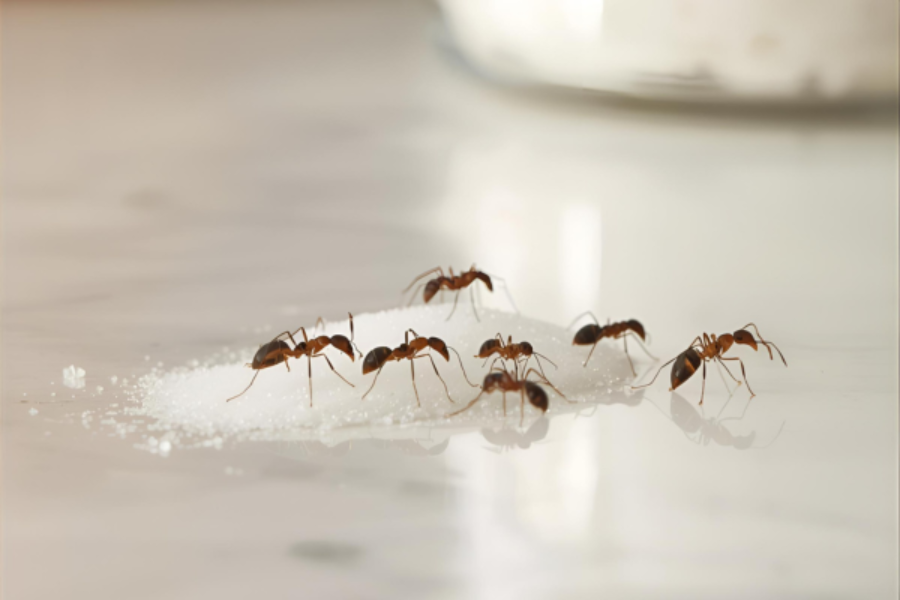Sugar ants, also known as odorous house ants, are tiny pests that can quickly become a huge nuisance in your kitchen. Their presence can disrupt your daily life, especially when you’re trying to cook or enjoy a meal. Worse still, they’re persistent little creatures that seem to appear out of nowhere and invade your kitchen, leaving a trail of frustration and inconvenience in their wake.
But don’t worry, you’re not alone. The good news is that getting rid of sugar ants doesn’t have to be a complicated task. In this guide, we’ll explore effective, easy-to-follow methods that you can use to eliminate sugar ants in your kitchen and prevent them from coming back. So, let’s roll up our sleeves and tackle this together!
Understanding Sugar Ants and Why They Invade Kitchens
What Are Sugar Ants?
Sugar ants, or odorous house ants, are small ants that typically range from 1/16 to 1/8 inch in length. They are dark brown to black in color and are known for the distinct odor they emit when crushed—hence the name “odorous.” Unlike other types of ants, sugar ants thrive on sugary foods, which makes your kitchen a perfect place for them to forage.
These ants can form large colonies, and they work together to find and transport food back to their nest, sometimes creating long lines that are visible as they scurry Cleaning Guide for Home & Kitchen across your counters or floors. If you’ve ever seen a trail of ants making their way to your sugar jar, then you’ve had a sugar ant problem on your hands.
Why Do Sugar Ants Target Kitchens?
Sugar ants are drawn to kitchens because of the abundance of food—especially sugary foods. If you’ve ever left a crumb of cake or a spilled sugary drink, you know how quickly they’ll show up. But it’s not just about sugar; they also love greasy, fatty foods and anything else that’s easy to access.
In addition to food, kitchens offer warmth and moisture, making them an ideal environment for sugar ants to thrive. Cracks in the walls, gaps around window frames, or holes near your pipes provide perfect entry points for them to invade your home.
Are Sugar Ants Harmful?
Sugar ants are not dangerous to humans in terms of stings or bites, but they can be a health concern. They can contaminate your food by leaving behind bacteria from their tiny feet, making it unsafe to eat food that they’ve touched. Their sheer numbers can also cause emotional frustration as they invade your kitchen, making it feel dirty and uninviting.
How to Identify a Sugar Ant Infestation in Your Kitchen
Common Signs of Sugar Ants
If you’ve noticed tiny ants on your kitchen counter or near food storage areas, you may already have an infestation. The most obvious sign is seeing ants marching in a straight line to and from food sources. They’ll often be found near sugar containers, fruit bowls, crumbs, or even inside sealed food containers if they’ve found a way in.
Another sign is seeing sugar ants inside food storage jars, such as sugar canisters, or near trash bins where food scraps are left.
How to Track Their Entry Points
Once you spot a trail of sugar ants, follow them to locate where they’re entering your kitchen. They often come in through tiny cracks in walls, window frames, or gaps around pipes and door frames. Tracking their movements can help you figure out their entry points and the potential location of the nest. This is crucial for effectively sealing those gaps and preventing future invasions.
How to Get Rid of Sugar Ants in Your Kitchen: Step-by-Step Guide
Now, let’s get to the heart of the matter—getting rid of those pesky sugar ants. Here’s a simple, actionable guide to help you eliminate them from your kitchen.
Step 1: Clean and Remove Food Sources
Sugar ants are attracted to food, so the first step in getting rid of them is to eliminate their food sources. Start by thoroughly cleaning your kitchen:
- Wipe down countertops and appliances.
- Sweep or vacuum the floors to remove crumbs, especially in corners or behind appliances.
- Empty trash cans regularly and ensure they’re sealed tightly.
- Store food in airtight containers to prevent ants from getting into your pantry.
Step 2: Use Ant Baits
Ant baits are one of the most effective ways to eliminate sugar ants. Ant baits contain a sweet substance that attracts the ants, and once they take the bait back to their colony, it poisons the nest. Place ant bait stations along the trails where you see ants, near entry points, or where you suspect the nest might be. Ants will carry the bait back to their colony, and within a few days, the infestation should subside.
Step 3: Apply Natural Remedies
If you prefer a more natural approach, you can use several common household ingredients that sugar ants hate. Some natural remedies include:
- Vinegar: Mix equal parts of white vinegar and water in a spray bottle and spray it on ant trails and entry points. The strong smell of vinegar disrupts the ants’ scent trail and discourages them from returning.
- Cinnamon: Sprinkle cinnamon around your kitchen or along entry points. Ants dislike the strong scent, and it acts as a natural barrier.
- Essential Oils: Oils like peppermint, tea tree, and eucalyptus can repel ants. Mix a few drops of your chosen oil with water and spray it around your kitchen or on ant trails.
Step 4: Seal Cracks and Entry Points
To prevent sugar ants from coming back, it’s essential to seal any cracks or entry points you’ve identified during your tracking process. Use caulk to seal gaps around windows, doors, and pipes. You can also add weatherstripping around doors to keep ants from sneaking inside. Proper maintenance of these seals is key to preventing future infestations.
Step 5: Use Chemical Ant Sprays (When Necessary)
If natural remedies and ant baits aren’t enough, consider using chemical insecticides as a last resort. Choose sprays that are specifically labeled for ant control. Be sure to follow the instructions carefully to avoid contamination of food surfaces. Use the spray around entry points and nests, but avoid spraying directly on countertops or food preparation areas.
Step 6: Call a Professional Exterminator
If the infestation is large or persistent, it might be time to call in a professional exterminator. They have the tools and expertise to deal with severe ant infestations and can help ensure that the colony is completely eliminated. Plus, they can provide long-term solutions and advice on how to prevent future infestations.
Preventing Future Sugar Ant Infestations in Your Kitchen
After getting rid of the sugar ants, you’ll want to take steps to ensure they don’t return.
Regular Kitchen Maintenance
Routine cleaning is key to keeping sugar ants at bay. Wipe down surfaces, clean up spills immediately, and keep food properly stored in sealed containers. Regularly check for signs of ants and deal with them promptly before they can form a colony.
Keep Doors and Windows Sealed
Maintaining weatherstripping and window screens is essential for preventing ants from getting inside. Make sure all seals around windows and doors are intact, and inspect for any new cracks that could be potential entry points.
Keep Food Stored Properly
One of the best ways to avoid sugar ants is to reduce the availability of food. Always store food in airtight containers and keep sugary foods, like candies and syrup, tightly sealed. Don’t leave pet food or leftovers out, as this can attract ants as well.
Natural Remedies vs. Chemical Solutions for Sugar Ants
Natural Remedies: Pros and Cons
Natural remedies are a great option if you’re looking for a safe and environmentally friendly way to deal with sugar ants. They’re non-toxic, so they’re safe for pets and children. Common natural ingredients like vinegar, cinnamon, and essential oils can be effective in repelling ants. However, they may not work as quickly or thoroughly as chemical treatments for large infestations.
Chemical Solutions: Pros and Cons
Chemical solutions are highly effective for eliminating large or stubborn sugar ant infestations. They can kill ants quickly and work well for well-established colonies. However, they come with some risks, such as exposure to harmful chemicals and contamination of food surfaces. Always read the labels and follow safety guidelines when using chemical ant sprays or baits.
When to Seek Professional Help for Sugar Ant Infestations
When DIY Methods Aren’t Working
If the infestation continues despite your best efforts, it’s time to call in the professionals. Large colonies can be difficult to deal with, and pest control experts have access to stronger, more effective treatments.
Long-Term Prevention by Professionals
Professional pest control services can provide long-term solutions, helping you prevent future infestations. They can also offer tips on maintaining a clean and ant-free kitchen.
FAQ Section
Q1: What attracts sugar ants to my kitchen?
Answer: Sugar ants are attracted to sugary foods, crumbs, spills, and even pet food left out. Moisture and warmth also play a role in drawing them inside.
Q2: How long does it take to get rid of sugar ants in my kitchen?
Answer: The time it takes to eliminate sugar ants depends on the size of the infestation. It could take anywhere from a few days to a couple of weeks to completely get rid of them.
Q3: Can I use homemade remedies to get rid of sugar ants?
Answer: Yes, many people find success with homemade remedies like vinegar, peppermint oil, and cinnamon. These are natural deterrents and can help reduce the infestation.
Q4: Are ant baits safe for pets and children?
Answer: Some ant baits are pet and child-safe, but it’s important to read the label and keep them out of reach. If you’re concerned, opt for natural remedies or consult with an expert.
Q5: What should I do if I still see ants after using ant baits?
Answer: If ants persist, it could mean the colony is large or well-established. Reapply baits, and consider sealing more entry points or calling a pest control professional.
Q6: How can I prevent ants from coming back?
Answer: Keep your kitchen clean, seal entry points, and store food properly. Regularly inspect your kitchen for potential new entryways for ants.
Conclusion
Dealing with sugar ants in your kitchen doesn’t have to be a nightmare. By following the steps in this guide, you can effectively get rid of sugar ants and prevent future infestations. Regular maintenance, proper food storage, and sealing entry points are the best ways to keep your kitchen ant-free. Remember, with a little time and effort, you can create a cleaner and healthier kitchen for you and your family.
So, take action today—eliminate those sugar ants and enjoy a pest-free kitchen!

